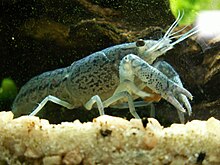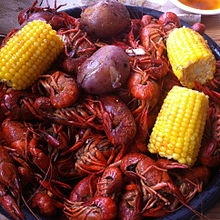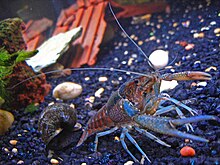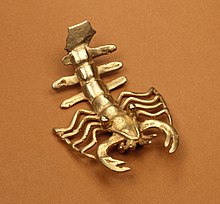Crayfish
| Crayfish Temporal range:
| |
|---|---|
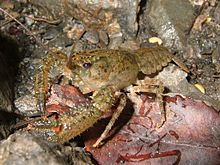
| |
| Northern kōura,Paranephrops planifrons(Parastacidae) | |
| Scientific classification | |
| Domain: | Eukaryota |
| Kingdom: | Animalia |
| Phylum: | Arthropoda |
| Class: | Malacostraca |
| Order: | Decapoda |
| Suborder: | Pleocyemata |
| (unranked): | Reptantia |
| Infraorder: | Astacidea |
| Superfamiliesandfamilies | |


Crayfish[a]are freshwatercrustaceansbelonging to the infraorderAstacidea,which also containslobsters.Taxonomically, they are members of thesuperfamiliesAstacoideaandParastacoidea.They breathe through feather-likegills.Some species are found in brooks and streams, wherefresh wateris running, while others thrive inswamps,ditches, andpaddy fields.Most crayfish cannot toleratepolluted water,although some species, such asProcambarus clarkii,are hardier. Crayfish feed on animals and plants, either living ordecomposing,anddetritus.[1]
The term "crayfish" is applied to saltwater speciesin some countries.
Terminology
[edit]The name "crayfish" comes from theOld Frenchwordescrevisse(Modern Frenchécrevisse).[2][3]The word has been modified to "crayfish" by association with "fish" (folk etymology).[2]The largelyAmericanvariant "crawfish" is similarly derived.[2]
Some kinds of crayfish are known locally aslobsters,[4]crawdads,[5]mudbugs,[5]andyabbies.In theEastern United States,"crayfish" is more common in the north, while "crawdad" is heard more in central and southwestern regions, and "crawfish" farther south, although considerable overlaps exist.[6]
The study of crayfish is called astacology.[7]
Anatomy
[edit]The body of adecapodcrustacean,such as a crab, lobster, or prawn (shrimp), is made up of twentybody segmentsgrouped into two main body parts, thecephalothoraxand theabdomen.Each segment may possess one pair ofappendages,although in various groups, these may be reduced or missing. On average, crayfish grow to 17.5 cm (6.9 in) in length. Walking legs have a small claw at the end.[8]
Diet
[edit]Crayfish are opportunisticomnivorousscavengers, with the ability to filter and process mud.[9]Inaquacultureponds usingisotope analysisthey were shown to build body tissue selectively from the animal protein portion of pelleted food and not the other components of the pellet.[10]
They have the potential to eat most foods, even nutrient poor material such as grass, leaves, and paper, but can be highly selective and need variety to balance their diet. The personalities of the individual crayfish can be a key determinant in the food preference behaviour in aquaria.[citation needed]
Crayfish all over the world can be seen in anecologicalrole ofbenthicdwellers, so this is where most of their food is obtained - at the sediment/water interface in ponds, lakes, swamps, or burrows. When the gut contents are analysed, most of the contents is mud: fine particulate organic matter (FPOM) and mixed particles of lignin and cellulose (roots, leaves, bark, wood).[11]Some animal material can also be identified, but this only contributes a small portion of the diet by volume.
They feed on submerged vegetable material at times, but their ability to catch large living animal material is restricted. They can feed oninterstitial organismsif they can be grasped in the small feeding claws. They can be lured into traps with an array of baits from dog biscuits, fish heads, meat, etc., all of which reinforces the fact that they are generalist feeders.
On a day-to-day basis, they consume what they can acquire in their immediate environment in limited space and time available -detritus.At a microbial level, the FPOM has a high surface area of organic particles and consists of a plethora ofsubstrateandbacteria,fungi,micro-algae,meiofauna,partially decomposed organic material and mucus. This mucus or "slime" is abiofilmand can be felt on the surface of leaves and sticks. Also crayfish have been shown to becoprophagic- eating their own faeces, they also eat their ownexuviae(moultedcarapace) and each other.[10]They have even been observed leaving the water to graze.[citation needed]
Detritus or mud is a mixture of deadplankton(plant and animal), organic wastes from thewater column,and debris derived from the aquatic and terrestrial environments. Mostly detritus is in the end phase of decomposition and is recognised as black organic mud. The crayfish usually ingest the material in only a few minutes, as distinct from grazing for many hours. The material is mixed with digestive fluids and sorted by size. The finer particles follow a slower and more exacting route through to thehindgut,compared to the coarser material. The coarser material is eliminated first and often reappears in approximately 10 to 12 hours, whereas the finer material is usually eliminated from 16 to 26 hours after ingestion.[12]
All waste products coming out through the hindgut are wrapped in aperitrophic membrane,so they look like a tube. Such an investment in the wrapping of the microbial free faeces in a protein rich membrane is most likely the reason they are coprophagic. Such feeding behaviour based on selection, ingestion, and extreme processing ensures periodic feeding, as distinct from continuous grazing. They tend to eat to satiation and then take many hours to process the material, leaving minimal chance of having more room to ingest other items. Crayfish usually have limited home range and so they rest, digest, and eliminate their waste, most commonly in the same location each day.
Feeding exposes the crayfish to risk of predation, and so feeding behaviour is often rapid and synchronised with feeding processes that reduce such risks — eat, hide, process and eliminate.
Knowledge of the diet of these creatures was considered too complex since the first book ever written in the field of zoology,The CrayfishbyT.H. Huxley(1879), where they were described as "detritivores".This is why most researchers have not attempted to understand the diet of freshwater crayfish. The most complex study which matched the structure and function of the whole digestive track with ingested material was performed in the 1990s by Brett O'Brien onmarron,[12]the least aggressive of the larger freshwater crayfish with aquaculture potential, similar to redclaw and yabbies.
Classification and geographical distribution
[edit]Crayfish are closely related tolobsters,and together they belong to theinfraorderAstacidea.Theirphylogenycan be shown in the simplifiedcladogrambelow:[13][14][15]
| Astacidea |
| ||||||
Fourextant(living)familiesof crayfish are described, three in theNorthern Hemisphereand one in theSouthern Hemisphere.The Southern Hemisphere (Gondwana-distributed) familyParastacidae,with 14 extant genera and two extinct genera, live(d) inSouth America,Madagascar,andAustralasia.They are distinguished by the absence of the first pair ofpleopods.[16]Of the other three Northern Hemisphere families (grouped in thesuperfamilyAstacoidea), the four genera of the familyAstacidaelive in westernEurasiaand westernNorth America,the 15 genera of the familyCambaridaelive in easternNorth America,and the single genus ofCambaroididaelive in easternAsia.[14]
North America
[edit]The greatest diversity of crayfish species is found in southeastern North America, with over 330 species in 15 genera, all in the family Cambaridae. A further genus of astacid crayfish is found in thePacific Northwestand the headwaters of some rivers east of theContinental Divide.Many crayfish are also found in lowland areas where the water is abundant incalcium,and oxygen rises from underground springs.[17]Crayfish are also found in some non-coastal wetlands; eight species of crayfish live inIowa,[18]for example.
In 1983,Louisianadesignated the crayfish, or crawfish as they are commonly called, as its official state crustacean.[19]Louisiana produces 100 million pounds (45 million kilograms) of crawfish per year with thered swampandwhite river crawfishbeing the main species harvested.[20]Crawfish are a part ofCajunculture dating back hundreds of years.[21]A variety of cottage industries have developed as a result of commercialized crawfish iconography. Their products include crawfish attached to wooden plaques, T-shirts with crawfish logos, and crawfish pendants, earrings, and necklaces made of gold or silver.[22]
Australia
[edit]Australiahas over 100 species in a dozengenera.It is home to the world's three largest freshwater crayfish:
- theTasmanian giant freshwater crayfishAstacopsis gouldi,which can achieve a mass over 5 kg (11 lb) and is found in rivers of northernTasmania[23]
- theMurray crayfishEuastacus armatus,which can reach 2.5 kg (5.5 lb), although reports of animals up to 3 kg (6.6 lb) have been made. It is found in much of the southernMurray-Darling basin.[24]
- themarronfromWestern Australia(now believed to be two species,Cherax tenuimanusandC. cainii) which may reach 2.2 kg (4.9 lb)
Many of the better-known Australian crayfish are of the genusCherax,and include thecommon yabby(C. destructor), western yabby (C. preissii), andred-claw crayfish(C. quadricarinatus).[25]
The marron speciesC. tenuimanusiscritically endangered,while other large Australasian crayfish are threatened or endangered.
New Zealand
[edit]InNew Zealand,two species ofParanephropsare endemic, and are known by theMāorinamekōura.[26]
Other animals
[edit]In Australia, New Zealand, andSouth Africa,[27]the term "crayfish" or "cray" generally refers to a saltwaterspiny lobster,of the genusJasusthat is indigenous to much of southernOceania,[28]while thefreshwaterspecies are usually calledyabbiesorkōura,from theindigenous Australianand Māori names for the animal, respectively, or by other names specific to each species. Exceptions includewestern rock lobster(of thePalinuridaefamily) found on the west coast of Australia (it is a spiny lobster, but not ofJasus);theTasmanian giant freshwater crayfish(from theParastacidaefamily and therefore a true crayfish) found only in Tasmania; and theMurray crayfishfound along Australia'sMurray River.[citation needed]
InSingapore,the term crayfish typically refers toThenus orientalis,a seawater crustacean from theslipper lobsterfamily.[29][30][31]True crayfish are not native to Singapore, but are commonly found as pets, or as an invasive species (Cherax quadricarinatus) in the many water catchment areas, and are alternatively known asfreshwater lobsters.[32]
In the United Kingdom and Ireland, the terms crayfish or crawfish commonly refer to theEuropean spiny lobster,a saltwater species found in much of the East Atlantic and Mediterranean.[33]The only true crayfish species native to the British Isles is the endangeredwhite clawed crayfish.[34][35]
Fossil record
[edit]Fossil burrows very similar in construction to those of modern crayfish and likely produced by early crayfish are known from theEarly Permian(~300-270 million years ago) of equatorialPangea,in what is now North America (Washington Formation), and Europe (Sardinia). The oldest body fossils assigned to crayfish are known from theLate Triassic(~230-200 million years ago)Chinle Formationof North America, assigned to the species "Enoploclytia"porteriandCamborygma eumekenomos,which are not assigned to any modern families. An indeterminate member of the modern familyCambaridaeis known from the Late JurassicMorrison Formationof North America.[36]The earliest records of other modern families date to the Early Cretaceous, including theparastacidPalaeoechinastacusfrom Australia which is 115 million years old,[37]thecambaroididPalaeocambarusfrom theYixian Formationof China which is likely around 120 million years old (Barremian-Aptian),[38]and theastacid"Austropotamobius"llopisifrom theLas Hoyassite inSpain(Barremian).[39]
Threats to crayfish
[edit]Crayfish are susceptible to infections such ascrayfish plagueand to environmental stressors including acidification. In Europe, they are particularly threatened by crayfish plague, which is caused by the North Americanwater moldAphanomyces astaci.This water mold was transmitted to Europe when North American species of crayfish were introduced.[40]Species of the genusAstacusare particularly susceptible to infection, allowing the plague-coevolvedsignal crayfish(native to western North America) to invade parts ofEurope.[41]
Acid raincan cause problems for crayfish across the world. In whole-ecosystem experiments simulating acid rain at theExperimental Lakes AreainOntario, Canada,crayfish populations crashed – probably because theirexoskeletonsare weaker inacidifiedenvironments.[42]
Invasive pest
[edit]In several countries, particularly in Europe, native species of crayfish are under threat by imported species, particularly the signal crayfish (Pacifastacus leniusculus).[43][44]Crayfish are also considered an invasive predatory species, endangering native European species such as theItalian agile frog.
Uses
[edit]Culinary use
[edit]Crayfish are eaten worldwide. Like other edible crustaceans, only a small portion of the body of a crayfish is eaten. In most prepared dishes, such as soups,bisquesandétouffées,only the tail portion is served. Atcrawfish boilsor other meals where the entire body of the crayfish is presented, other portions, such as the claw meat, may be eaten.[citation needed]
Research shows that crayfish do not die immediately when boiled alive, and respond to pain in a similar way to mammals. Then the stress hormone cortisol is released and this leads to the formation of lactic acid in the muscles, which makes the meat taste sour. Crayfish can be cooked more humanely by first freezing them unconscious for a few hours, then destroying the central nervous system along their abdomen by cutting the crayfish lengthwise with a long knife down the center of the crayfish before cooking it.[45]
Global crayfish production is centered in Asia, primarily China. In 2018, Asian production accounted for 95% of the world's crawfish supply.[46]
Crayfish is part ofSwedish cuisineand is usually eaten in August at specialcrayfish parties(Swedish:Kräftskiva). Documentation of the consumption of crayfish dates to at least the 16th century. On the Swedish west coast,Nephrops norvegicus(Havskräfta,lit. 'sea crayfish') is more commonly eaten while various freshwater crayfish are consumed in the rest of the country. Prior to the 1960s, crayfish was largely inaccessible to the urban population in Sweden and consumption was largely limited to the upper classes or farmers holding fishing rights in fresh water lakes. With the introduction of import of frozen crayfish the crayfish party is now widely practiced across all spheres in Sweden and among theSwedish-speaking population of Finland.[47]
In the United States, crayfish production is strongly centered inLouisiana,with 93% of crayfish farms located in the state as of 2018.[48]In 1987, Louisiana produced 90% of the crayfish harvested in the world, 70% of which were consumed locally.[49]In 2007, the Louisiana crayfish harvest was about 54,800 tons, almost all of it fromaquaculture.[50]About 70–80% of crayfish produced in Louisiana areProcambarus clarkii(red swamp crawfish), with the remaining 20–30% beingProcambarus zonangulus(white river crawfish).[51]Optimum dietary nutritional requirement of freshwater crayfish, or crayfish nutrient specifications are now available for aquaculture feed producers[52]
Like all crustaceans, crayfish are notkosherbecause they are aquatic animals that do not have bothfinsandscales.[53]They are therefore not eaten by observantJews.[54]
Bait
[edit]Crayfish are preyed upon by a variety ofray-finned fishes,[55]and are commonly used asbait,either live or with only the tail meat. They are a popular bait for catchingcatfish,[56]largemouth bass,smallmouth bass,striped bass,[57]perch,pike[58]andmuskie.When using live crayfish as bait, anglers prefer to hook them between the eyes, piercing through their hard, pointed beak which causes them no harm; therefore, they remain more active.[59]
When using crayfish as bait, it is important to fish in the same environment where they were caught. AnIllinois State Universityreport that focused on studies conducted on theFox RiverandDes Plaines Riverwatershed stated thatrusty crayfish,initially caught as bait in a different environment, were dumped into the water and "outcompeted the native clearwater crayfish".[60]Other studies confirmed that transporting crayfish to different environments has led to various ecological problems, including the elimination of native species.[61]Transporting crayfish as live bait has also contributed to the spread ofzebra musselsin various waterways throughout Europe and North America, as they are known to attach themselves to exoskeleton of crayfishes.[62][63][64]
Pets
[edit]Crayfish are kept as pets in freshwater aquariums. They prefer foods like shrimp pellets or various vegetables, but will also eat tropical fish food, regular fish food, algae wafers, and small fish that can be captured with their claws. A report by theNational Park Service[65]as well as video and anecdotal reports by aquarium owners[66]indicate that crayfish will eat their moulted exoskeleton "to recover the calcium and phosphates contained in it."[65]As omnivores, crayfish will eat almost anything; therefore, they may explore the edibility of aquarium plants in a fish tank. However, most species of dwarf crayfish, such asCambarellus patzcuarensis,will not destructively dig or eat live aquarium plants.[67]
In some nations, such as theUnited Kingdom,United States,Australia,andNew Zealand,imported alien crayfish are a danger to local rivers. The three most widespread American species invasive in Europe areFaxonius limosus,Pacifastacus leniusculusandProcambarus clarkii.[40]Crayfish may spread into different bodies of water because specimens captured for pets in one river are often released into a different catchment. There is a potential for ecological damage when crayfish are introduced into non-native bodies of water: e.g.,crayfish plaguein Europe, or the introduction of the common yabby (Cherax destructor) into drainages east of the Great Dividing Range in Australia.[68]
Education
[edit]Somepublic schoolsin the United States keep live crayfish in the classroom and have the students take care of them in order to give the students a greater understanding of the creatures.[69]
Sentinel species
[edit]The Protivin brewery in theCzech Republicuses crayfish outfitted with sensors to detect any changes in their bodies or pulse activity in order to monitor the purity of the water used in their product. The creatures are kept in a fish tank that is fed with the same local natural source water used in their brewing. If three or more of the crayfish have changes to their pulses, employees know there is a change in the water and examine the parameters.[70]
Scientists also monitor crayfish in the wild in natural bodies of water to study the levels of pollutants there.[70][71][72]
See also
[edit]Notes
[edit]- ^In some locations, they are also known asbaybugs,crabfish,craws,crawfish,crawdaddies,crawdads,freshwater lobsters,mountain lobsters,mudbugs,rock lobsters,signal crawfish,oryabbies.
References
[edit]- ^Christoph Needon; Johannes Petermann; Peter Scheffel; Bernd Scheibe (1971).Plants and Animals (Pflanzen und Tiere).Leipzig: Urania Verlag.
- ^abc"crayfish".Oxford English Dictionary(Online ed.).Oxford University Press.(Subscription orparticipating institution membershiprequired.)
- ^Wedgwood, Hensleigh(1855)."On False Etymologies".Transactions of the Philological Society(6): 65.
- ^C. W. Hart Jr. (1994). "A dictionary of non-scientific names of freshwater crayfishes (Astacoidea and Parastacoidea), including other words and phrases incorporating crayfish names".Smithsonian Contributions to Anthropology.38(38): 1–127.doi:10.5479/si.00810223.38.1.hdl:10088/1372.S2CID86017542.
- ^abPableaux Johnson."Mudbug Madness: Crawfish".Bayou Dog. Archived fromthe originalon 19 August 2006.Retrieved28 August2006.
- ^Bert Vaux; Scott A. Golder."Dialect survey".Harvard University.Retrieved30 September2006.
- ^"About the International Association of Astacology".Archived fromthe originalon 5 April 2005.
- ^"What Is the Difference Between Walking Legs and Chelipeds in Crayfish?".Pets on Mom.com.Retrieved12 June2021.
- ^O'Brien, Brett G. (1990). "Feeding Biology of Marron Cherax tenuimanus Decapoda: Parastacidae".National Symposium of Freshwater Crayfish Culture Proceedings:89–104.
- ^abO'Brien, B.G.; Davies, P.M. (2002). "The structure of marron(Cherax tenuimanus)food webs in commercial ponds: results from multiple stable isotope analyses ".Freshwater Crayfish.13(1): 155–163.
- ^O'Brien, Brett G. (1995). "The natural diet of the freshwater crayfishCherax tenuimanus(Smith 1912) (Decapoda: Parastacidae) as determined by gut content analysis ".Freshwater Crayfish.10(1): 151-162.
- ^abO'Brien, Brett G. (1994).The Feeding Biology of Marron.The University of Western Australia. p. 273.
- ^Wolfe, Joanna M.; Breinholt, Jesse W.; Crandall, Keith A.; Lemmon, Alan R.; Lemmon, Emily Moriarty; Timm, Laura E.; Siddall, Mark E.; Bracken-Grissom, Heather D. (24 April 2019)."A phylogenomic framework, evolutionary timeline and genomic resources for comparative studies of decapod crustaceans".Proceedings of the Royal Society B.286(1901).doi:10.1098/rspb.2019.0079.PMC6501934.PMID31014217.
- ^abCrandall, Keith A.; De Grave, Sammy (2017)."An updated classification of the freshwater crayfishes (Decapoda: Astacidea) of the world, with a complete species list".Journal of Crustacean Biology.37(5): 615–653.doi:10.1093/jcbiol/rux070.
- ^Heather D. Bracken-Grissom; Shane T. Ahyong; Richard D. Wilkinson; Rodney M. Feldmann; Carrie E. Schweitzer; Jesse W. Breinholt; Matthew Bendall; Ferran Palero; Tin-Yam Chan; Darryl L. Felder; Rafael Robles; Ka-Hou Chu; Ling-Ming Tsang; Dohyup Kim; Joel W. Martin; Keith A. Crandall (July 2014)."The Emergence of Lobsters: Phylogenetic Relationships, Morphological Evolution and Divergence Time Comparisons of an Ancient Group (Decapoda: Achelata, Astacidea, Glypheidea, Polychelida)".Systematic Biology.63(4): 457–479.doi:10.1093/sysbio/syu008.PMID24562813.
- ^Horton H. Hobbs Jr.(1974). "Synopsis of the families and genera of crayfishes (Crustacea: Decapoda)".Smithsonian Contributions to Zoology.164(164): 1–32.doi:10.5479/si.00810282.164.S2CID86685246.
- ^Steve Pollock (2005).Eyewitness Ecology.New York,United States:Dorling Kindersley.ISBN978-0-7894-5581-9.
- ^"What's a Mudbug?"(Press release).Iowa Department of Natural Resources.12 July 2022.
- ^"The Crawfish – Louisiana's State Crustacean".American Profile. 11 August 2002.Retrieved25 November2017.
- ^"Crawfish Louisiana State Crustacean".State of Louisiana-Department of Administration.3 June 2014.Retrieved25 November2017.
- ^"Crawfish Deeply Rooted in Louisiana Culture".Voice of America. 19 April 2016.Retrieved25 November2017.
- ^Gutierrez, C. Paige (1 January 2012).Cajun Foodways.University Press of Mississippi. p. 78.ISBN9781604736021.Retrieved25 November2017.
- ^"Tasmanian Giant Freshwater Lobster (Astacopsis gouldi) ".Department of the Environment, Water, Heritage and the Arts.9 February 2007.Retrieved16 March2010.
- ^Fisheries Scientific Committee (2013)."The Murray crayfish – Euastacus armatus as a Vulnerable Species"(PDF).NSW Department of Primary Industries.Archived(PDF)from the original on 1 April 2015.Retrieved11 March2019.
- ^Michael P. Masser; David B. Rouse (1997)."Australian Red Claw Crayfish"(PDF).SRAC Publication(244). Archived fromthe original(PDF)on 13 May 2005.
- ^"Kōura".NIWA.26 May 2009.Retrieved18 September2012.
- ^"Lobsters, rock lobsters and crayfish".Western Australian Museum.Retrieved30 November2019.
- ^Harold W. Sims Jr. (1965). "Let's call the spiny lobster" spiny lobster "".Crustaceana.8(1): 109–110.doi:10.1163/156854065X00613.JSTOR20102626.
- ^"Sweet Chilli Crayfish ( long mã tinh thần )".mywoklife.com.13 February 2010.
- ^"FAR OCEAN SEA PRODUCTS (PRIVATE) LIMITED".dollarvietnam.com.
- ^Classic Asian Noodles.Marshall Cavendish. 2007.ISBN978-9812613356.
- ^Shane T. Ahyong; Darren C. J. Yeo (2007)."Feral populations of the Australian Red-Claw crayfish (Cherax quadricarinatus von Martens) in water supply catchments of Singapore ".Biol Invasions.9(8): 943–946.Bibcode:2007BiInv...9..943A.doi:10.1007/s10530-007-9094-0.
- ^"European spiny lobster (Palinurus elephas)".The Marine Life Information Network.Archivedfrom the original on 7 April 2016.Retrieved17 October2021.
- ^"White-clawed (or Atlantic stream) crayfish (Austropotamobius pallipes) - Special Areas of Conservation".sac.jncc.gov.uk.Retrieved17 October2021.
- ^"White-clawed crayfish | Shropshire Wildlife Trust".www.shropshirewildlifetrust.org.uk.Retrieved17 October2021.
- ^Audo, Denis; Hasiotis, Stephen T; Kawai, Tadashi (1 December 2023)."Diversity and evolutionary history of fossil crayfishes".Journal of Crustacean Biology.43(4).doi:10.1093/jcbiol/ruad079.ISSN0278-0372.
- ^Martin, Anthony J.; Rich, Thomas H.; Poore, Gary C.B.; Schultz, Mark B.; Austin, Christopher M.; Kool, Lesley; Vickers-Rich, Patricia (2008)."Fossil evidence in Australia for oldest known freshwater crayfish of Gondwana".Gondwana Research.14(3): 287–296.Bibcode:2008GondR..14..287M.doi:10.1016/j.gr.2008.01.002.ISSN1342-937X.
- ^"Crayfishes from the Jehol biota".Geodiversitas.45(24): 689–719. 2023.
- ^García-Penas, Álvaro; Ferratges, Fernando Ari; Moreno-Bedmar, Josep Anton; Bover-Arnal, Telm; Gasca, José Manuel; Aurell, Marcos; Zamora, Samuel (2023)."Decapod crustaceans from the Lower Cretaceous of Spain, with an account of new occurrences in Barremian-Aptian strata of the Maestrazgo Basin".Cretaceous Research.150:105576.Bibcode:2023CrRes.15005576G.doi:10.1016/j.cretres.2023.105576.ISSN0195-6671.
- ^abJames R. Lee (5 December 1998)."TED Case Studies Crayfish Plague #478 European Crayfish Dispute".Archived fromthe originalon 10 January 2009.Retrieved20 January2008.
- ^"Nonindigenous Aquatic Species - Pacifastacus leniusculus".Retrieved6 July2020.
- ^"A Canadian Scientist Explains How Acid Rain is Still Making its Mark".IISD Experimental Lakes Area.16 May 2018.Retrieved6 July2020.
- ^"Invading Europe's waterways: The crayfish occupation".19 December 2019.
- ^"Invasive species: Why Britain can't eat its way out of its crayfish problem".13 October 2020.
- ^Alström, Vivvi (12 August 2023)."Forskning visar: Kräftor känner smärta när de kokas levande".SVT Nyheter(in Swedish).Retrieved12 August2023.
- ^"Global Aquaculture Production: Procambarus clarkii, 1990-2018".FAO Fisheries Division.Food And Agriculture Organization of the United Nations.Retrieved21 March2021.
- ^Po Tidhom (2004). "The Crayfish Party". The Swedish Institute. Archived from the original on 4 February 2009. Retrieved 29 January 2006.
- ^"Table 18. Crustacean Sales by Species: 2018 and 2013"(PDF).2018 Census of Agriculture.USDA, National Agricultural Statistics Service.Archived(PDF)from the original on 19 December 2019.Retrieved21 March2021.
- ^Larry W. de la Bretonne Jr. & Robert P. Romaire (1990)."Crawfish production: harvesting, marketing and economics"(PDF).SRAC Publication(242). Archived fromthe original(PDF)on 12 December 2010.
- ^"1978–2007: Louisiana Summary of Agriculture and Natural Resources"(PDF).Louisiana State University Agricultural Center, Baton Rouge, Louisiana. 2009. Archived fromthe original(PDF)on 2 April 2012.
- ^"Differences Between Red Swamp Crawfish and White River Crawfish".The Louisiana State University Agricultural Center.Archived fromthe originalon 18 July 2011.Retrieved25 February2009.
- ^Lunda, Roman; Roy, Koushik; Dvorak, Petr; Kouba, Antonin; Mraz, Jan (2020)."Recycling biofloc waste as novel protein source for crayfish with special reference to crayfish nutritional standards and growth trajectory".Scientific Reports.10(1): 19607.Bibcode:2020NatSR..1019607L.doi:10.1038/s41598-020-76692-0.PMC7658255.PMID33177672.
- ^"Kosher defined".Triangle K.Retrieved1 December2010.
- ^Meyer-Rochow, Victor Benno (2009)."Food taboos: their origins and purposes".Journal of Ethnobiology and Ethnomedicine.5–18:18.doi:10.1186/1746-4269-5-18.PMC2711054.PMID19563636.
- ^Web, Animal Diversity (16 September 2002)."Kids' Inquiry of Diverse Species, Orconectes propinquus, northern clearwater crayfish: INFORMATION".BioKIDS.Retrieved27 July2018.
- ^Samsel, Jeff (5 August 2005)."5 Great Catfish Baits".Game & Fish.Archived fromthe originalon 8 November 2021.Retrieved13 February2021.
- ^"Striped Bass Feeding Facts and Information".Bass Fishing Gurus.4 March 2015.Retrieved27 July2018.
- ^"The Key to Locating Bass, Walleye or Pike".Funny Fishing Tshirts & Fishing Gifts – Fish Face.25 August 2017. Archived fromthe originalon 27 July 2018.Retrieved27 July2018.
- ^Bean, Richard Alden (6 April 2011)."Crayfish: What Better Spring Bait For Bass?".Game & Fish.Retrieved27 July2018.
- ^"Fox and Des Plaines Rivers Watershed"(PDF).Critical Trends in Illinois Ecosystems.Illinois Department of Natural Resources.2001. Archived fromthe original(PDF)on 27 March 2009.Retrieved10 February2009.
- ^Tennessee Aquatic Nuisance Species Task Force (2007).Tennessee Aquatic Nuisance Species Management Plan(PDF).Tennessee Wildlife Resources Agency.Archived(PDF)from the original on 9 September 2008.
- ^"Hawaii Risk Analyses and Management for Dreissenid Mussels"(PDF).US Fish & Wildlife. 2012. p. 3.Archived(PDF)from the original on 30 October 2014.Retrieved27 July2018.
- ^"zebra mussel (Dreissena polymorpha) – Species Profile".Nonindigenous Aquatic Species.16 November 2005.Retrieved27 July2018.
- ^J. Thompson; F. Parchaso; A. Alpine; J. Cloern; B. Cole; O. Mace; J. Edmunds; J. Baylosis; S. Luoma; F. Nichols (13 December 2007)."The History and Effects of Exotic Species in San Francisco Bay".United States Geological Survey.Archived fromthe originalon 1 July 2013.Retrieved10 February2009.
- ^ababebault (May 2013)."Crayfish Facts".Google.Archived fromthe originalon 16 February 2017.Retrieved27 July2018.
- ^"YouTube".YouTube.12 April 2018. Archived fromthe originalon 30 October 2021.Retrieved27 July2018.
- ^Gerald Pottern."Mexican dwarf orange crayfish,Cambarellus patzcuarensis".Archived fromthe originalon 28 July 2018.Retrieved13 October2010.
- ^Coughran, J; Mccormack, R; Daly, G (2009)."Translocation of the YabbyCherax destructorinto eastern drainages of New South Wales, Australia ".Australian Zoologist.35:100–103.doi:10.7882/AZ.2009.009.Retrieved10 May2018.
- ^"Crayfish give fourth graders a" pinch "of science education".The Castle Pines Connection.1 June 2011.Retrieved13 June2024.
- ^abHanrahan, Mark (27 September 2017)."Crayfish staff help Czech brewery keep its water as pure as can be".Reuters TV.Archived fromthe originalon 25 October 2019.Retrieved25 October2019.
- ^"Clean Water".Missouri Conservationist Magazine.Vol. 69, no. 11. Missouri Department of Conservation. November 2008. Archived fromthe originalon 25 October 2019.Retrieved25 October2019.
- ^Schilderman, P. A. E. L.; Moonen, E. J. C.; Maas, L. M.; Welle, I.; Kleinjans, J. C. S. (1999). "Use of Crayfish in Biomonitoring Studies of Environmental Pollution of the River Meuse".Ecotoxicology and Environmental Safety.44(3): 241–252.Bibcode:1999EcoES..44..241S.doi:10.1006/eesa.1999.1827.ISSN0147-6513.PMID10581118.
Further reading
[edit]- Christoph Goessmann; Charlotte Hemelrijk; Robert Huber (2000)."The formation and maintenance of crayfish hierarchies: behavioral and self-structuring properties"(PDF).Behavioral Ecology and Sociobiology.48(6): 418–428.doi:10.1007/s002650000222.S2CID9288247.Archived(PDF)from the original on 7 September 2006.
- Thomas Henry Huxley(1880).The Crayfish: an Introduction to the Study of Zoology.New York: D. Appleton & Co.
- Sterling K. Johnson; Nathan K. Johnson (2008).Texas Crawdads.College Station, Texas: Crawdad Club Designs.ISBN978-0-9801103-0-2.
- Regional European Crayfish Workshop: Future of Native Crayfish in Europe.Knowledge and Management of Aquatic Ecosystems.No. 394–395 (2009).
- Jerry G. Walls (2009).Crawfishes of Louisiana.Baton Rouge, LA: Florida State University Press.ISBN978-0-8071-3409-2.


